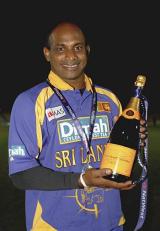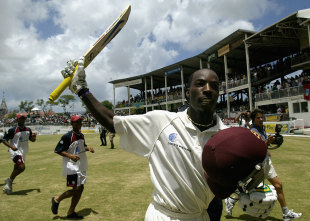The regular Monday column in which Steven Lynch answers your questions about (almost) any aspect of cricket:
I didn't see much written about Andrew Strauss's feat of scoring a century in his first Test as captain. How often has this been done for England? asked Terry Browne from Southampton
Andrew Strauss did indeed score a century in his first Test in charge, with 128 against Pakistan
at Lord's in July. Rather surprisingly, he is only the third England captain to start with a hundred. The previous man to do it was also a stand-in - Allan Lamb, who made 119 against West Indies
at Bridgetown in 1989-90 while deputising for Graham Gooch. The only other England captain to do it was way back in 1897-98 - Archie MacLaren, with 109 against Australia
at Sydney. He was
also a deputy - the tour captain was Drewy Stoddart.
Sanath Jayasuriya recently passed 150 in successive ODIs - has anyone else done this, and has anyone made more one-day 150s? asked an awful lot of people from Sri Lanka
Sanath Jayasuriya made 152 for Sri Lanka against England
at Headingley in the final ODI against England on July 1, 2006, and added 157 three days later against the Netherlands
at Amstelveen. It was indeed the first time anyone had passed 150 in consecutive ODI appearances. The second one was Jayasuriya's fourth score of 150 or more in ODIs, which is indeed another record. Chris Gayle and Brian Lara have made three, as did Viv Richards (who also had a score of 149), while Sourav Ganguly, Herschelle Gibbs, Adam Gilchrist, Andrew Symonds and Sachin Tendulkar have all passed 150 twice. For a list of the highest individual scores in ODIs,
click here.
How many people called Murray have kept wicket in Tests? asked Brian Bharat from the United States
There have been four with that surname - three of them from the West Indies. The first was
John Murray, the stylish Middlesex keeper, who played 21 Tests for England in the 1960s. He just beat the Trinidadian
Deryck Murray, who won the first of his 62 Test caps in 1963. He was followed into the West Indies team by the Barbadian
David Murray - confusingly they went on quite a few tours together - then
Junior Murray, the first Grenadian to play in a Test, won 33 caps between 1993 and 2002. Three other people with the surname Murray - Anton from South Africa, and the New Zealanders Bruce and Darrin - have played Test cricket, but weren't wicketkeepers.
Murray Bisset, an early South African player, kept wicket in two of his three Tests - and captained his side in the other one.
Was Justin Langer's 342 the highest score by an Australian in England, or did Don Bradman ever beat it? asked Christopher Johnstone from Sussex
Justin Langer's 342 for Somerset against Surrey
at Guildford last week was higher than
Don Bradman ever managed in England - his top score was 334, against England in the 1930
Headingley Test. But one Aussie has managed a higher score than Langer's -
Charles Macartney made 345 for the touring Australians against Nottinghamshire
at Trent Bridge in 1921. Macartney scored his runs in 232 minutes on the first day - he hit 47 fours and four sixes - and his 345 remained a record for a single day in first-class cricket until Brian Lara beat it during his 501 not out in 1994.
Did Don Bradman score a century in each session when he made his 309 not out at Headingley? asked Anand Seemangal from the United States
Don Bradman's 334
at Headingley in 1930, which is referred to above, did include 309 on the first day - but he didn't quite make a hundred in each session. He came in the second over of the match, after Archie Jackson was dismissed, and had 105 by lunch, only the third time anyone had made a century before lunch on the first day of a Test (and it has happened only once since). Bradman made 115 more before tea, by which time he was 220 not out, but managed "only" 89 more runs before the close. His last scoring shot of that first day took him past 2,000 first-class runs for the season - on July 11th. Next day The Don carried on to 334, which remained his highest Test score, before being caught behind off Maurice Tate.
I was stumped by a question on a bottle-top recently: "What are the ten modes of dismissal?" I had to look the tenth one up, and found the one I'd missed was Timed Out. Has anyone ever been Timed Out in Test or first-class cricket? asked David Lemin from Australia
A batsman can be Timed Out, under Law 31, if he is not ready to take strike within three minutes of the fall of the previous wicket. It has never happened in Test cricket - or not yet, anyway - but there are four such instances in first-class cricket. In 1997-98
Hemulal Yadav of Tripura was given out in this way against Orissa in a Ranji Trophy match
at Cuttack, after apparently showing no inclination to go in and start his innings after a drinks break.
Vasbert Drakes, the West Indian fast bowler, is down on the scorecard as Timed Out for Border against Free State
at East London in 2002-03: he was rather unfortunate as he wasn't even in the country at the time - his plane to South Africa had been delayed and he had not arrived. The most recent instance was in England in 2003, when Nottinghamshire's
Andrew Harris took too long to get to the crease while playing against Durham UCCE
at Trent Bridge. Harris was injured and hadn't expected to bat, but tried to get out to the middle to help Chris Read reach a century. He didn't make it in time, and Read was stranded on 94. The recent decision to recognise as first-class the matches played under the auspices of the non-white South African Cricket Board from 1971-72 provided the fourth (and earliest) example: playing against Transvaal at Port Elizabeth in 1987-88, Eastern Province's Andrew Jordaan, who was not out overnight, failed to arrive in time next morning as the roads were bad after a downpour.
And there's an addition to one of last week's answers, from Peter Worth
"Regarding your answer about
Robin Jackman's all-run six in the Surrey-Yorkshire Sunday League match in 1974 - I was actually at The Oval that day and saw it. I was but 12 years old at the time, but I recall it as follows: The wicket was placed on the far opposite side of the square (away from the gasholders) and most of the ground was in use as the playing field - giving one very long boundary and one quite short one. Jackman was batting at the pavilion end and cut Mike Bore (I think) to third man. He set off at a gallop, as did the fielder when he realised that the ball was not going to cross the boundary. An early example of relay throwing followed, and the relay fielder hurled the ball at the wicketkeeper's end, trying to run out Intikhab Alam, who was going for the third run. Unfortunately he throw was well wide of the mark, defeating David Bairstow and the backing-up fielders. The ball whistled through wide mid-on, and Jackman called for two runs on the overthrow. The fielder at wide mid-on, seeing Intikhab struggling to complete the fifth run, had another go at the wicketkeeper's end trying to run him out. Another wayward throw went past Bairstow - allowing Jackman to call Intikhab for the sixth run (in spite of the fact that Intikhab had gone well past the stumps) and the second wayward throw was fielded by the fielder who had originally fielded the ball on the third-man boundary, on his way back to his fielding position! This fielder finally managed to return the ball safely to Bairstow. Jackman was out soon after, and actually fell to his knees just in front of the pavilion on his way back to the dressing-room, reducing most of the crowd to tears of laughter!"



